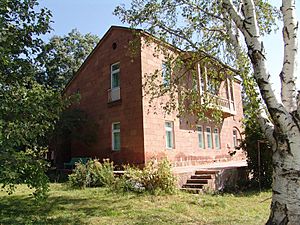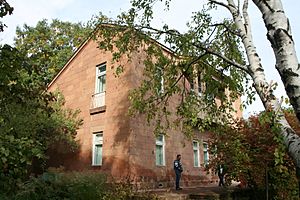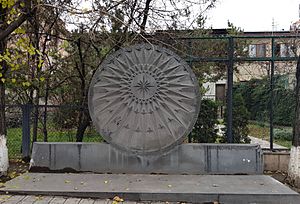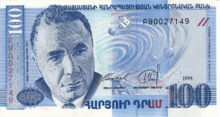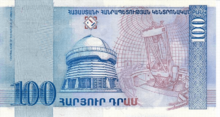Viktor Ambartsumian facts for kids
Quick facts for kids
Viktor Ambartsumian
|
|
|---|---|
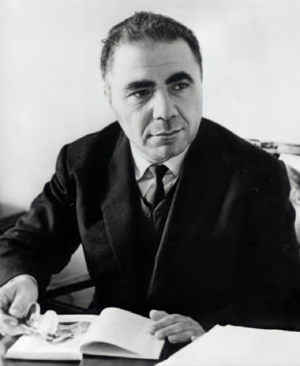 |
|
| Born | 18 September [O.S. 5 September] 1908 |
| Died | 12 August 1996 (aged 87) Byurakan, Armenia
|
| Resting place | Byurakan Observatory |
| Citizenship | Russian Empire, Soviet Union, Armenia |
| Alma mater | Leningrad State University |
| Known for | Stellar association |
| Spouse(s) |
Vera Klochikhina
(m. 1930; died 1995) |
| Children | 4, including Rouben |
| Awards | Gold Medal of the Royal Astronomical Society (1960) Bruce Medal (1960) ForMemRS (1969) Lomonosov Gold Medal (1971) National Hero of Armenia (1994) State Prize of Russia (1995) |
| Scientific career | |
| Fields | Astrophysics |
| Institutions | Leningrad State University Pulkovo Observatory Yerevan State University Byurakan Observatory |
| Thesis | None |
| Doctoral advisor | Aristarkh Belopolsky |
| Doctoral students | Viktor Sobolev, Benjamin Markarian, Grigor Gurzadyan |
| Influenced | Subrahmanyan Chandrasekhar, Halton Arp, Geoffrey Burbidge, Adriaan Blaauw |
| Signature | |
 |
|
Viktor Amazaspovich Ambartsumian (Russian: Виктор Амазаспович Амбарцумян; Armenian: Վիկտոր Համազասպի Համբարձումյան, Viktor Hamazaspi Hambardzumyan; 18 September 1908 – 12 August 1996) was a famous Armenian astrophysicist. He was a top astronomer of the 20th century. Many people see him as the person who started theoretical astrophysics in the Soviet Union.
Viktor Ambartsumian studied at Leningrad State University (LSU) and the Pulkovo Observatory. He taught at LSU and started the first astrophysics department in the Soviet Union there in 1934. Later, he moved to Soviet Armenia. In 1946, he founded the Byurakan Observatory. This observatory became a major center for studying space. He also helped create the Armenian Academy of Sciences and led it for nearly 50 years. Some people said that "science in Armenia was like the name Ambartsumian." In 1965, he started the journal Astrofizika. He was its editor for more than 20 years.
Ambartsumian started to retire from his many jobs when he was 80 years old. He passed away at his home in Byurakan. He was buried at the observatory. In 1994, he was named a National Hero of Armenia.
Contents
Early Life and Learning
Growing Up in Tiflis
Viktor Ambartsumian was born in Tiflis on September 18, 1908. His mother was Hripsime Khakhanian and his father was Hamazasp Hambardzumyan. His father was a writer and translator. He even translated Homer's Iliad into Armenian. In 1912, his father helped start a group for Armenian writers. The famous poet Hovhannes Tumanyan was its president.
Viktor had a brother named Levon and a sister named Gohar. Levon studied geophysics but passed away young. Gohar became a mathematician and taught at Yerevan State University.
School Days and Early Interests
Ambartsumian loved mathematics from a young age. He could multiply numbers by age four. His interest in astronomy began when he was 11. He read a Russian book about the stars. He said he decided to become an astronomer at age 12. From 1917 to 1924, he went to schools in Tiflis. He studied under Nikolay Ignatievich Sudakov, an astronomer who taught him a lot.
Ambartsumian worked with Sudakov at the school observatory. He wrote papers on astronomy and gave talks about the Solar System and extraterrestrial life. He started giving these talks when he was just 12 or 13. In 1924, he even gave a lecture at Yerevan State University about the theory of relativity.
University Studies
In 1924, Ambartsumian moved to Leningrad. He first went to the Herzen Pedagogical Institute. After a year, he moved to Leningrad State University (LSU). He studied both astronomy and mathematics there. He said, "I loved mathematics, but I felt my job would be astronomy." He graduated in 1928. His main project was about how light moves through space. He then continued his studies at the Pulkovo Observatory until 1931. His teacher there was Aristarkh Belopolsky.
His Work as a Scientist
Starting in Leningrad
After his studies, Ambartsumian started working at the Pulkovo Observatory in 1931. He also taught part-time at LSU. He gave the first course on theoretical astrophysics in the Soviet Union. He also did some administrative work at Pulkovo. He later said Pulkovo was "the best qualified astronomical institution" in the Soviet Union.
In 1934, Ambartsumian left Pulkovo. He then started the first department of astrophysics in the Soviet Union at Leningrad State University. He became a professor at LSU in 1934. In 1935, he was named a doctor of physical-mathematical sciences. He led the department until 1946 or 1947. From 1939 to 1941, he was also the director of the Astronomical Observatory of LSU. He was also a deputy president of the university. Many of his students became important scientists.
During World War II, Ambartsumian helped move part of LSU's faculty to Elabuga. He led this branch of the university until 1944.
Moving to Armenia
In 1943, Ambartsumian and his family moved to Yerevan, Soviet Armenia. He lived there for the rest of his life. In the same year, he helped create the Armenian Academy of Sciences. He was its vice president until 1947. Then, he became its president, a role he held for 46 years until 1993.
From 1943, Ambartsumian also directed the Yerevan Astronomical Observatory. In 1945–1946, he started the astrophysics department at Yerevan State University (YSU). He taught there until 1994. In 1965, Ambartsumian started the journal Astrofizika. He was its main editor until 1987. This journal is still published today.
Building Byurakan Observatory
In 1946, Ambartsumian founded the Byurakan Astrophysical Observatory. It is located in the village of Byurakan, on the slopes of Mount Aragats. The first buildings were finished in 1951. The observatory officially opened in 1956. Ambartsumian lived at the observatory in a house he built with prize money. He directed the Byurakan Observatory until 1988. It was his main workplace until he passed away in 1996.
In 1960, Ambartsumian got a large Schmidt telescope for Byurakan. This telescope helped scientists discover the Markarian galaxies. Many international meetings were held at Byurakan. In 1968, the observatory received a high award from the Soviet Union. Ambartsumian and his students at Byurakan became known as the "Byurakan School." Scientists from many countries came to study there.
The Byurakan Observatory helped put Armenia on the map for astronomy. It became one of the world's top centers for studying astrophysics.
Important Discoveries
Ambartsumian did important research in astronomy and how the universe began. He studied nebulae (clouds of gas and dust), star systems, and distant galaxies.
Stellar Associations
In 1947, Ambartsumian discovered stellar associations. These are new types of star groups. This discovery showed that new stars are still forming in our Milky Way galaxy. At first, many scientists were unsure about this idea. But Ambartsumian observed that certain types of stars clustered loosely. He realized these groups were unstable and would spread out over time. This meant stars are born in groups and continue to form. His discovery changed how scientists thought about star formation.
Active Galactic Nuclei (AGN)
In the mid-1950s, Ambartsumian started studying the centers of galaxies. He found that groups of galaxies were unstable. This suggested that galaxies were still forming. At a big conference in 1958, he talked about the amazing activity in the centers of galaxies. He said that "huge explosions take place in galactic nuclei." He also believed these centers must have very massive, unknown objects. Scientists later accepted the idea of active galactic nuclei (AGN). This was especially true after quasars were found in 1963.
Radiative Transfer
Ambartsumian also made key discoveries about how light and energy move through space. This is called radiative transfer. He was one of the first to study how stars transfer radiation in gas clouds. He also found ways to calculate how star clusters break apart.
In 1943, he came up with the "principle of invariance." This idea helps understand how light reflects from surfaces. It has been used in many other areas of science. Another famous scientist, Subrahmanyan Chandrasekhar, said Ambartsumian's ideas were very important.
Astronomy from Space
Ambartsumian was a pioneer in doing astronomy from Soviet spacecraft. His student, Grigor Gurzadyan, led this program. In 1971, the Salyut 1 space station carried Orion 1. This was the first space telescope with a special prism. In 1973, the Soyuz 13 mission used the Orion-2 telescope. It took images of thousands of stars in ultraviolet light. These space missions were possible because of Ambartsumian's strong connections and skills.
Mathematics
Ambartsumian also contributed to mathematics. In 1929, he wrote a paper that introduced the inverse Sturm-Liouville problem. This problem is about how the vibrations of a string relate to its properties. His paper became an important topic for research many years later.
Leading Science
In the Soviet Union
Ambartsumian became a member of the USSR Academy of Sciences in 1953. He was part of its main governing body. He also led the council for astronomy. This meant he was one of the most powerful scientists in the Soviet Union. He often led Soviet groups at international science meetings. He was also on the editorial boards of important astronomy journals.
In Armenia
Ambartsumian was a co-founder of the Armenian Academy of Sciences in 1943. He became its president in 1947. He held this position for 46 years until 1993. When he stepped down, he was named its honorary president.
He had a huge impact on science in Soviet Armenia. He helped develop many fields like physics, mathematics, and engineering. He also played a role in setting up the Yerevan Computer Research and Development Institute in 1956. Ambartsumian was also the main editor of the Armenian Soviet Encyclopedia. This large encyclopedia was published in 12 volumes from 1974 to 1986.
Around the World
Ambartsumian had a strong influence on international astronomy. He was a member of the International Astronomical Union (IAU) since 1946. He was its vice-president from 1948 to 1955. Then, he was its president from 1961 to 1964. He strongly believed in international cooperation in science. He said that studying space together helps different nations understand each other better.
He also led the International Council of Scientific Unions (ICSU) from 1968 to 1972. He was the first person from the Eastern European countries to be elected to this role.
His Views and Beliefs
Science and Society
Ambartsumian wrote books and articles about philosophy. He believed that science and philosophy should work together to understand nature. He was an atheist, meaning he did not believe in God. He thought science and religion were different. For many years, he led an organization that promoted science over religion. However, he also felt that Christianity was important for Armenian identity. He had good relationships with the head of the Armenian Apostolic Church.
Political Involvement
Ambartsumian was a member of the Communist Party of the Soviet Union (CPSU) from 1940. He was also a member of the Supreme Soviet of the Soviet Union, which was like the parliament, from 1950 to 1989. He was loyal to the Soviet system. But he also spoke up when politics got in the way of his research. He was able to travel to Western countries, which was unusual for Soviet scientists.
Supporting Armenian Causes
Ambartsumian loved the Armenian language and supported its use. He made sure all official communication at the Armenian Academy of Sciences was in Armenian. He often gave speeches at important Armenian events.
In 1965, he spoke about the Armenian genocide. This was a terrible event where many Armenians were killed. He connected it to the revival of the Armenian people in Soviet Armenia. In 1975, he wrote that the genocide was like the Holocaust.
In 1989, he protested a decision about Nagorno-Karabakh. This was a region with many Armenians that was under the control of Azerbaijan. In 1990, he even went on a hunger strike to protest this. He wanted Nagorno-Karabakh to be part of Armenia. He said that the government should follow its own laws. He ended his strike after 9 days when a religious leader asked him to.
When the Soviet Union broke apart, Ambartsumian was sad. But he voted for Armenia's independence in 1991. He was happy for independent Armenia, but knew it would be difficult.
Personal Life
When people called Ambartsumian a Russian scientist, he would correct them. He would say he was Armenian. He spoke Armenian very well. He lived in both Yerevan and Byurakan. He built a house at the Byurakan Observatory. He also had a house in Yerevan.
His Personality and Family
People described Ambartsumian as a kind and humble man. He was very smart and had a strong personality. He said his only passion was science. But he also loved poetry and music.
In 1930 or 1931, he married Vera Fyodorovna. She was an English teacher. She helped him read his papers in English. They had four children: Karine, Yelena, Rafayel, and Rouben. All of their children became scientists. He was very sad when his wife passed away in 1995.
Later Years and Passing
Ambartsumian started to retire from his jobs in 1988 when he was 80. He left his role as director of the Byurakan Observatory that year. He also stepped down as president of the Armenian Academy of Sciences in 1993.
He passed away at his home in Byurakan on August 12, 1996. He was buried at the observatory next to his wife and parents. Thousands of people attended his funeral. In 1998, his house was opened as a museum.
How He Is Remembered
Ambartsumian was one of the most important astrophysicists and astronomers of the 20th century. He is known as the founder of theoretical astrophysics in the Soviet Union. He was also well-respected around the world. He was an honorary member of science academies in over 25 countries.
Even during the Cold War, he was well-liked in the United States. He was the first Soviet scientist to become an honorary member of the American Academy of Arts and Sciences. A U.S. Congressman once introduced him as "the world's greatest astronomer."
In Armenia
Ambartsumian is seen as a modern hero in Armenia. He is recognized as the most important scientist in Armenia in the 20th century. Some say he was the greatest since the 7th-century scholar Anania Shirakatsi. In 1994, he was given the title of a National Hero of Armenia. This was for his important scientific work and his love for his country.
Honors and Tributes
- An asteroid discovered in 1972 was named 1905 Ambartsumian after him.
- In 1998, Armenia celebrated his 90th birthday. The International Astronomical Union held a meeting at Byurakan. The Central Bank of Armenia also released a 100-dram banknote with his picture.
- The Byurakan Observatory was officially named after him.
- Other things named after him include a chair at Yerevan State University, a street, a park, a school in Yerevan, and a college in Vardenis.
- In 2009, a large bronze statue of Ambartsumian was put up in Yerevan. Busts (head and shoulders statues) of him are also in other places.
Viktor Ambartsumian International Prize
In 2009, the President of Armenia started an international prize in Ambartsumian's memory. It is given every two years. This prize is considered one of the most important awards in astronomy.
Awards and Honors
State Awards
|
Professional Awards
|
Memberships
- Soviet Union
- Corresponding Member of the USSR Academy of Sciences (1939)
- Full member (Academician) of the Armenian SSR Academy of Sciences (1943)
- Full member (Academician) of the USSR Academy of Sciences (1953)
- Honorary member of the Academies of Sciences of the Georgian SSR and Azerbaijan SSR
- Abroad
Ambartsumian was elected honorary and foreign member of 28 Academies of Sciences, including:
- Honorary Member of the American Astronomical Society (1947)
- Associate of the Royal Astronomical Society (1953)
- Corresponding member (1958) and foreign associate (1978) of the French Academy of Sciences
- Foreign Honorary Member of the American Academy of Arts and Sciences (1958)
- Foreign Associate of the U.S. National Academy of Sciences (1959)
- Honorary Member of the Royal Astronomical Society of Canada (1959)
- Foreign Member of the Royal Society (1969)
Honorary Degrees
Ambartsumian received special degrees from several universities: Australian National University (1963), University of Paris (1967), University of Liège (1967), Charles University in Prague (1967), Nicolaus Copernicus University in Toruń (1973), National University of La Plata (1974).
See also
 In Spanish: Víktor Hambardzumyan para niños
In Spanish: Víktor Hambardzumyan para niños
- Armenians in Tbilisi



